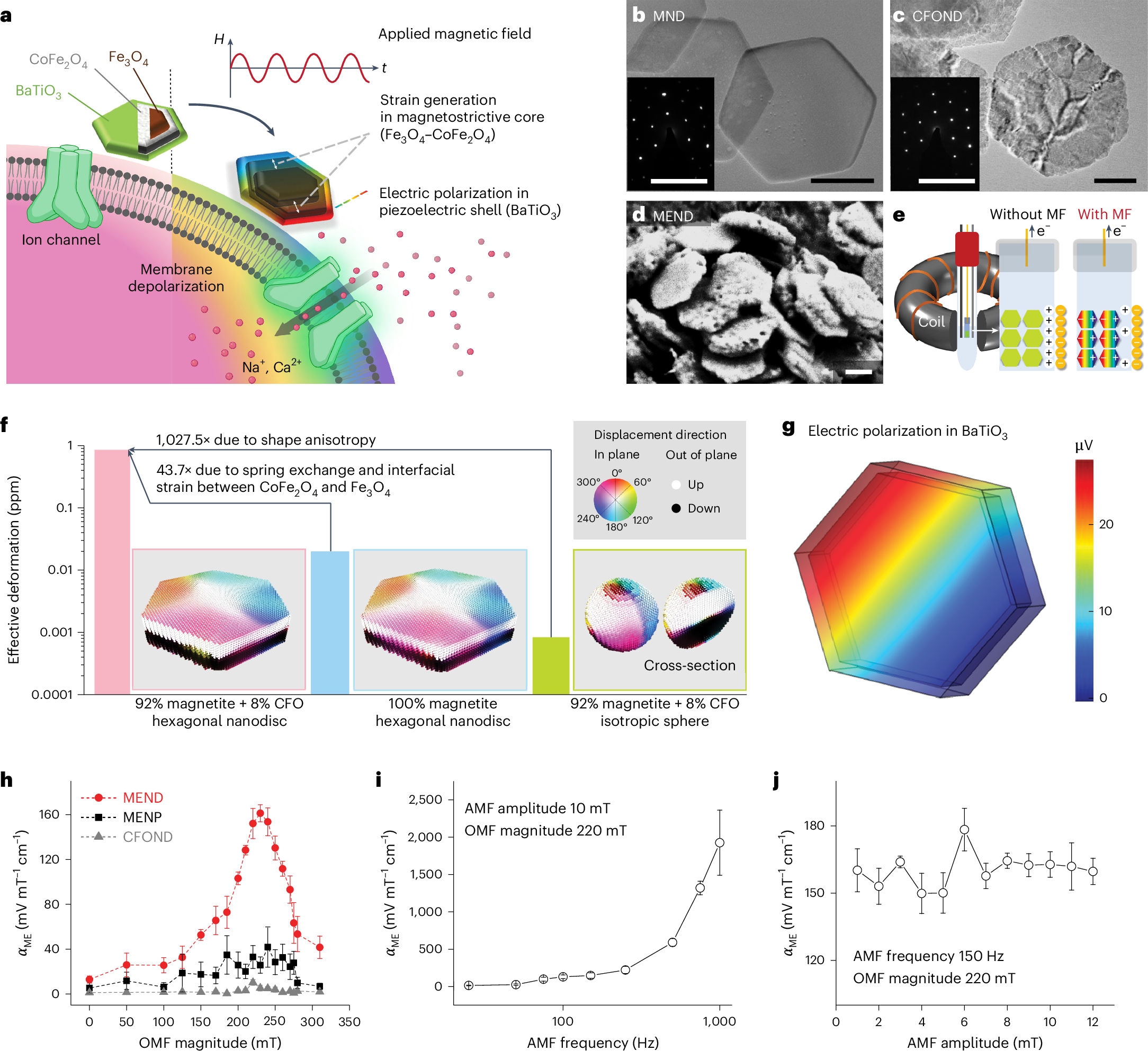Molecular Architects of the Mind: Magnetoelectric Nanodiscs for Precision Neuromodulation
Magneto-electric nano-discs (MENDs) represent a breakthrough in wireless neuromodulation, offering a less invasive alternative to deep brain stimulation (DBS). Developed by MIT researchers, these nanodiscs are poised to transform how we think about brain stimulation therapies. At approximately 250 nanometers in size—about 1/500 the width of a human hair—MENDs can be injected directly into the brain and activated remotely via an external magnetic field. This eliminates the need for surgically implanted electrodes or genetic modification, both of which have limited the clinical application of DBS.
The core–double-shell structure of MENDs, comprising layers of magnetostrictive and piezoelectric materials (Fe₃O₄, CoFe₂O₄, and BaTiO₃), enables them to convert magnetic signals into electrical stimulation. The team’s use of disc-shaped nanostructures significantly enhances the magnetoelectric effect, with magnetostriction amplified over 1,000-fold compared to conventional spherical nanoparticles. This enhanced precision allows MENDs to deliver finely-tuned electrical pulses directly to targeted neurons, even at low concentrations, creating an exciting new frontier in neuroscience research and therapeutic applications.

Figure 1. Schematic and TEM images of MENDs showing their core–double-shell structure, which enables magnetoelectric neuromodulation.
One critical question is: How effective are these nanodiscs in comparison to traditional DBS? The study showed that MENDs could reliably stimulate deep brain regions such as the ventral tegmental area (VTA) and the subthalamic nucleus (STN)—regions associated with reward processing and motor control, respectively. This is particularly noteworthy because these are the same areas targeted by DBS for conditions like Parkinson’s disease. By activating the VTA, the researchers were able to influence reward-related behaviours in mice, while STN stimulation successfully modulated motor control, demonstrated by the controlled rotational movement of mice.

Figure 2. Neurons decorated with MENDs showing increased fluorescence after magnetic stimulation, indicating successful neuronal activation in vitro.
The subsecond precision of MEND-mediated stimulation is comparable to traditional electrodes, but with far fewer foreign body responses, indicating a safer and potentially more efficient method of neuromodulation.
But what about the long-term implications? Beyond basic research, MENDs hold promise for clinical use in conditions where traditional DBS is too invasive or risky. While the current results are promising, further refinement is needed to maximize the conversion of magnetostrictive effects into electrical output. The research team is focused on enhancing the magnetoelectric coupling to push the limits of this technology. Additionally, long-term biocompatibility remains a focus of ongoing research, with preliminary studies showing that MENDs cause minimal inflammatory response compared to traditional DBS electrodes, making them a viable option for chronic use.

Figure 3. Confocal images of c-Fos-expressing neurons in mouse brain regions after MEND-mediated stimulation, demonstrating the technology’s in vivo efficacy.
In the context of broader biomedical applications, MENDs could be adapted for more than just neurological conditions. Their ability to provide precise, localized stimulation opens up possibilities for treating psychiatric disorders or even enabling brain-computer interfaces without the need for permanent implants. Moreover, as the team envisions, once further testing is completed, MENDs could be applied to human trials, offering hope for non-invasive, highly controlled brain stimulation therapies that could revolutionize the treatment of neurological and psychiatric conditions.
Overall, MENDs represent a paradigm shift in neuromodulation technology. Their ability to stimulate deep brain regions without surgery, implants, or genetic modification holds immense potential for both research and clinical applications. While there is more work to be done in optimizing their magnetoelectric efficiency, the groundwork has been laid for a future where brain stimulation is not only more accessible but also safer and more precise. This research opens up exciting new possibilities in the treatment of conditions like Parkinson’s disease, obsessive-compulsive disorder, and beyond, marking a significant step forward in the field of neuroscience and biomedical engineering.
Reference:
https://news.mit.edu/2024/tiny-magnetic-discs-offer-remote-brain-stimulation-without-transgenes-1011
Cover image:
Image credits:
Kim, Y.J., Kent, N., Vargas Paniagua, E. et al. Magnetoelectric nanodiscs enable wireless transgene-free neuromodulation. Nat. Nanotechnol. (2024). https://doi.org/10.1038/s41565-024-01798-9


Comments
Post a Comment